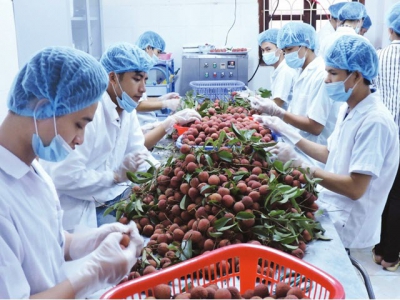Fruit, vegetable exports expected to thrive this year

Vietnam’s fruit and vegetable exports are expected to thrive in 2021 despite the Covid-19 pandemic.
China accounting for 59.1 percent of market share
According to the Agro Processing and Market Development Authority under the Ministry of Agriculture and Rural Development, Vietnam’s fruit and vegetable exports reached an estimated US$300 million in February, bringing total value in the first two months of the year to US$610 million, an increase of 14.6 percent compared to a year ago.
In January, China was the biggest export market for Vietnam’s fruit and vegetables with US$182.9 million, accounting for 59.1 percent of market share, followed by Thailand with US$16.2 million (5.2 percent), the US with US$13.2 million (4.3 percent), and Japan with US$10.5 million (3.4 percent).
In the first month, Vietnam’s exports of fruit and vegetables recorded strong growth in the Ukraine (11-fold increase), Cambodia (8.4-fold increase), and Egypt (5-fold increase), while plunging 68.6 percent, 57.8 percent, 33.3 percent, and 18.5 percent in Laos, Indonesia, Germany, and the Republic of Korea, respectively.
Vietnam’s fruit and vegetable imports reached an estimated US$110 million in February, bringing total value in the first two months of the year to US$259 million, a year-on-year increase of 30.7 percent. In January, China, the US and Myanmar were Vietnam’s three largest suppliers of fruit and vegetables.
Nguyen Quoc Toan, director of the Agro Processing and Market Development Authority, said that as the Covid-19 pandemic lingers, processed products will help increase the export value of fruit and vegetables.
Improving quality
Vietnam has boosted exports of fruit and vegetables to many potential markets since the beginning of the year, such as Egypt, Kuwait, the Ukraine, and Senegal, raising hopes of increasing the export value in 2021 and beyond.
In particular, China has increased its imports of Vietnamese fruit to serve the coming Spring Festival. At the Pingxiang border gate, China’s largest inland fruit trading port, trucks loaded with dragon fruit, jackfruit, watermelon, mango and other Vietnamese fruit stand in line to enter China. After being strictly disinfected and implementing other measures to prevent the spread of the Covid-19 pandemic, fruit trucks are taken to the customs control area for inspection. Fruit is shipped from the Pingxiang fruit market to Guangzhou and Zhejiang, and from there across the country. In addition, Vietnamese fruit has also been introduced into China’s shopping malls.
With the effect of the UK-Vietnam Free Trade Agreement (UKVFTA), which has abolished more than 94 percent of the total 547 tariff lines for Vietnamese fruit and vegetables, many products in which Vietnam excels, such as litchi, longan, rambutan, dragon fruit, pineapple and melon will have advantages in competing with rivals.
However, Vietnam’s fruit and vegetable production remains fragmented, while the application of product traceability is difficult and expensive. Safe fruit and vegetable production according to VietGAP and GlobalGAP standards remains modest, accounting for only 10-15 percent of the total growing area.
China is cracking down on imports with strict QR product traceability codes, while imposing bans on unofficial imports. Chinese consumers are increasingly paying attention to quality and safety of agricultural products and foodstuffs, meaning that Vietnamese businesses need to improve the quality of their fruit and vegetable products in order to meet consumer demand.
The 2020 Regional Comprehensive Economic Partnership (RCEP) provides opportunities for Vietnam to promote fruit and vegetable exports to member countries, especially China.
Có thể bạn quan tâm
 Hoa Binh makes moves to boost export of agricultural products
Hoa Binh makes moves to boost export of agricultural products Hoa Binh has a number of agricultural products farmed on commercial scale, such as longan, dragon fruit, banana, winter melon
 Surpassing Thailand, Vietnamese rice ranks first in world on price
Surpassing Thailand, Vietnamese rice ranks first in world on price Overcoming Thailand and India, Vietnamese rice ranked first in the world on average selling price, which in the first quarter was US$547 per ton, up 18.6%
 Coffee exports fall by over 11 percent in Q1
Coffee exports fall by over 11 percent in Q1 Vietnam exported 428,000 tonnes of coffee worth 771 million USD in the first quarter of 2021, down 17 percent in volume and 11.3 percent in value year on year